Top News
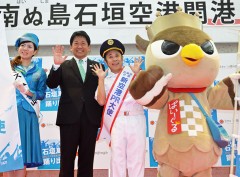
March 9, 2013 Ryukyu Shimpo
On March 8, the Ishigaki Municipal Government appointed Takashi Okamura, a Japanese comedian and one half of the duo Ninety-nine, as a promotional ambassador for New Ishigaki Airport. That same day, at the ceremony to mark his appointment, Okamura promised to market the airport to the main islands of
Japan, boldly saying, “Welcome to the New Ishigaki Airport!”
Cheered by his fans, Okamura who has attracted consistently high viewer ratings on Japanese TV, wore a Top Gun pilot costume and aviator sunglasses as he came onto the stage. Okamura warmed the audience up by copying the dance Painushima, performing it to the promotional song of the airport.
A genuine fan of Ishigaki, Okamura has been visiting the island for diving for over ten years. He praised the sea around Ishigaki Island, saying, “I often go to Hawaii and Saipan, but I think that the sea around Ishigaki is clearer and more beautiful.” He went on to say, “I love to eat Yaeyama soba here every day.” At the same time, Okamura made the audience laugh, saying, “I was thinking about promoting the various attractions of Ishigaki Island, but then I realized that I’m now a promotional ambassador for the New Ishigaki Airport, so I’ll concentrate on promoting the airport.”
(English translation by T&CT, Mark Ealey)
Go to Japanese
March 9, 2013 Ryukyu Shimpo
Is this also part of the “Abe brand”? Starting this year, Prime Minister Shinzo Abe plans to hold a ceremony on April 28 to commemorate the anniversary of the restoration of Japanese sovereignty after the San Francisco Peace Treaty took effect in 1952.
Abe explained the reasoning for holding the ceremony as, “There are a growing number of young people who do not know that Japan was under U.S. occupation for seven years. It is important to be aware that Japan achieved independence 60 years ago.” We wonder if announcing the ceremony gave Abe the feeling that he is politician who is devoting himself to Japan.
It would seem that not even in the deepest recesses of his mind did Abe think of April 28, 1952 in terms of the humiliation it brought for Okinawa. While Japan regained independence that day, Okinawa was separated from Japan along with the Amami Islands in Kagoshima Prefecture and placed under U.S. occupation.
After Japan regained its sovereignty, the people of Okinawa experienced years of humiliation under U.S. military occupation, and even after returning to Japanese sovereignty in 1972, they have asserted that because local residents have been forced to shoulder the heavy burden of hosting U.S. bases the sovereign power of Japan clearly does not extend as far as Okinawa. Is it that the people in Okinawa are not part of the “Beautiful Japan” proclaimed by Abe?
However, what has happened to the sovereign power that Japan supposedly regained when it cut Okinawa adrift? The U.S. Marine Corps MV-22 Osprey aircraft have now started to fly in the skies over “Beautiful Japan.” Some intellectuals even suggest that Japan is being transformed into another Okinawa. With foreign military aircraft flying in its skies can Abe put his hand over his heart and confidently say that Japan is an independent sovereign state?
In 2004, when a military helicopter operating out of U.S. Marine Corp Futenma Air Station crashed on the campus of Okinawa International University, the U.S. military excluded Okinawan police from the scene of the accident. This is the reverse of what should have happened.
As symbolized by the Futenma relocation issue, and the forcing through of the deployment of the Osprey aircraft to Okinawa, the Japanese government is shamelessly obsequious towards the United States. We suspect that the reality of Japanese government’s position even after April 28, 1952 has continued to be one of subordination to the U.S. government.
While anti-U.S. military base sentiment does exist in Okinawa, it is rooted in the reality of having been forced to shoulder an excessive burden through the years. The Okinawan people are not anti-American. After the war, many went to study in the United States and learned about American democracy. Okinawan people view the post-war culture that developed in Koza City (currently Okinawa City) as a positive aspect of Okinawa’s rich cultural history.
In that context, we would like to reiterate that the people of Okinawa see the date of April 28 as a day of humiliation, and request that the Japanese government does something tangible to rectify the excessive burden of hosting U.S. military bases.
If Abe feels that an increasing percentage of our population does not know about April 28, then he should clearly explain its merits and demerits to the Japanese people.
If he plans to hold a ceremony to commemorate the April 28 anniversary of Japan’s restoration of independence after the U.S. occupation without touching on the humiliation that the people of Okinawa suffered, then April 28 will be a day that serves to do nothing more than remind the Okinawan people of the ever-deepening structural discrimination that forces them to shoulder an excessive burden.
(English translation by T&CT, Mark Ealey)
Go to Japanese
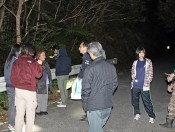
February 24, 2013 Ryukyu Shimpo
In the Yambaru areas of the northern part of Okinawa, local people are going on patrols to protect rare animals and plants. The main purpose of their activities is to prevent poaching and theft of plants, but they also enjoy roaming through the Yambaru forest while on patrol. The patrols are also being carried out in an attempt to reiterate the importance of the Yambaru forest, which is included on the tentative list of nominees for UNESCO World Heritage registration.
The Yambaru Wildlife Conservation Center of the Ministry of the Environment organized this patrol activity in cooperation with the Council for Conservation of the Yambaru Forest and local residents, and has carried out the patrol in Oku, Benoki and Yona in Kunigami, and Takazato in Ogimi. Reiko Takizawa, a native conservation ranger at the center said, “Through the patrols, we want people to be aware of their own community.”
On February 16, ten residents from the Yona district of Kunigami participated in the patrol with Yasuo Yamakawa, the Council for Conservation of the Yambaru Forest vice-chairman and Nozomi Murakami, a photographer from the Shinsei Publishing Company. They listened to an explanation about nature from relevant experts, saw fruit bats and heard the sound of the endangered Ishikawa’s frog. Kunigami Junior High School pupil Anzu Oshiro who participated in the patrol with her mother, said, “I thought that there would be many living creatures out here, so I was very glad that I heard the sound of many of them.”
After the patrol, the participants wrote the names of animals, plants and trash that they saw on the community store board which is used for sharing information on nature.
Mamoru Miyagi, resident of Yona who participated for the third time said, “I have seen someone trying to steal plants. We need to act now in order to protect the Yambaru.”
(English translation by T&CT, Hitomi Shinzato and Mark Ealey)
Go to Japanese

February 22, 2013 Ryukyu Shimpo
On February 21, at the Ukinju hainju in Hyakuna, Nanjo in Tamagusuku, the Ueda Ugan was held. It is a traditional ceremony in the Nakandakari district, in which people plant rice and pray for a good harvest. The place was known to be a center of rice cultivation for the Ryukyus.
The ceremony is held on the first day of the Ox after the lunar New Year. After praying at a sacred place called Meji known to be where a crane that had flown from China dropped ears of rice, people moved to Ueda’s rice fields at the Ukinju hainju. Three men from the community planted rice.
This year, pupils from Hyakuna Elementary School visited to observe the ceremony for the first time. With other people from the community the children clasped their hands in prayer.
Shinji Shiroma, who planted rice for the first time said, “This is very precious experience for me. I am prepared to take the lead in continuing this traditional ceremony.”
(English translation by T&CT, Megumi Chibana and Mark Ealey)
Go to Japanese

Go To Video
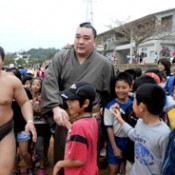
February 21, 2013 Ryukyu Shimpo
On February 20, Yokozuna Harumafuji and Aminishiki, sumo wrestlers who belong to the Isegahama stable, started training in the grounds of Toyomi Elementary School in Tomigusuku. Harumafuji, who was undefeated in the January Tournament said, “I will practice hard to go through undefeated in the next tournament.”
He talked about his impressions of Okinawa, saying that it’s warmer than Tokyo and that the children have energized him. “It’s not just practice. I would like to meet as many Okinawan people as possible,” said Harumafuji with a smile.
Wrestlers practiced sparring and other training methods for about two hours as children of the Toyomi Elementary School watched. Harumafuji signed autographs for fans and agreed to have take photographs taken with them.
The wrestlers of the stable came to Okinawa on February 19 for the training camp, which will run until February 23. In addition to training, there will be time to interact with pupils of the school and to visit welfare facilities.
(English translation by T&CT, Lima Tokumori and Mark Ealey)
Go to Japanese

Go To Video

February 21, 2013 Ryukyu Shimpo
On February 20, a representative of the Kunigami Education Board announced that five or six sets of human remains and some ornaments have been found in the Hedo district of Kunigami in a burial urn in the tomb in which Gihon, a king of the Ryukyu Islands who was the third and last of the Shunten Lineage, is believed to have been buried. Although there are several tombs believed to belong to Gihon in Okinawa, progress in technology means that there is now a greater chance of proving Gihon was buried in the tomb in Hedo. That same day, the board opened the tomb to the public for the first time.
Gihon was born in 1206 and assumed the throne during the Gusuku period of the Ryukyu kingdom in 1249. From the next year, Gihon’s reign was marked by a series of terrible disasters, including famine and epidemics that led to the death of nearly half of the population. He appointed a young lord by the name of Eiso as a regent (sessei) to manage state affairs. Eleven years after that, Gihon gave up the throne in favor of Eiso. It is believed that Gihon abdicated and withdrew into the forest alone because of the devastation in the kingdom and the change of lineage. There are several tombs believed to belong to Gihon in Kunigami and Kitanakagusuku.
The human remains were found in an urn about one meter in diameter. It appears that the urn was placed inside before the tomb was completed because the urn is bigger than the entrance to the tomb. Shinya Akamine, a curator of the board who is investing the tomb, said that when the members of the board opened the tomb, the urn was found broken on the side, where the human remains were exposed. They found ornaments around lying around it.
It is reported that members of the Sho family that ruled the Ryukyu Kingdom from early in the 15th century through to 1879, renovated the tomb during the early Meiji period. The tomb is three meters by three meters, and is made of Ryukyu limestone.
Naomi Doi, part-time lecturer in anthropology at the University of the Ryukyus, who is investigating the Urasoe Yodore Royal Mausoleum, which houses the remains of the rulers of the Ryukyu Island such as Eiso, said, “We have found three sets of human remains in the Yodore. Although we cannot conclude that the tomb in Hedo belongs to Gihon, it might be his because the facial structure of the human remains has the features of the Gusuku period.”
The members of the board will continue to analyze the human remains and the urn, including trying to determine its age. The municipal government will restore the tomb this year, and plan to make it into a sightseeing spot.
(English translation by T&CT, Mark Ealey)
Go to Japanese
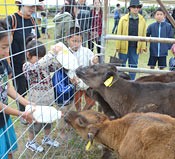
March 2, 2013 Ryukyu Shimpo
On February 24, the 21st cattle festival was held at the multipurpose plaza on Kuroshima Island, Taketomi-cho, in Yaeyama. As many as 3000 people took part in the festival, enjoying events such as a lottery in which people win pregnant cows. At the stalls, they tasted the food of Kuroshima, which is a livestock-farming island. The most popular dish was grilled beef shanks, which sold out as soon as they went on sale. Those fortunate enough to buy some enjoyed the taste of the juicy meat. Many tourists played games such as rolling a pasture grass roll, in which teams of six people competed with each other in rolling about 400 kilograms of grass, and an obstacle course in which a pair of a man and woman participate.
Families also enjoyed the opportunity to interact with cattle by nursing calves and watching a demonstration of cattle hoof trimming.
Mito Ishigaki, a nine year-old from Kohama-jima, Taketomi-cho, said with a smile, “I gave milk to a calf for the first time. I was so surprised that the calf was strong enough to pull me along. But it was very cute.”
(English translation by T&CT, Mark Ealey)
Go to Japanese
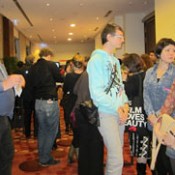
March 4, 2012 Kumiko Hokama, Correspondent of Ryukyu Shimpo
From February 7 to 17, one of the world’s leading festivals of its kind, the Berlin International Film Festival, was held. For the first time, this year the Okinawa Prefectural Government and the Okinawa Film Office of the Okinawa Convention and Visitors Bureau set up an Okinawa booth at a film trade fair called the European Film Market. They introduced Okinawan films such as Edonobori-The Spirit of Ryukyu, Okinawa Karate: Indomitable Shorin ryu Shubukan Uema Dojo, the Okinawa Competition Film Collection and Halser Acre.
The European Film Market operates from two venues, promoting film trading and advertising locations for shooting in each booth.
The Okinawan booth was set up in a corner of the second venue at the Marriott Hotel. There were fewer visitors there compared with the first venue, but the Okinawan booth stood out thanks to an array of eye-catchingly beautiful posters.
Hiroshi Arakawa, the senior supervisor of the Okinawa Film Office said, “This is the first time for us to run a booth, and it also allowed us to do some market research. I think that our participation will help promote the Okinawan name.” There were screening shows for buyers for Edonobori – The Spirit of Ryukyu on February 9, and Karakara (director Claude Gagnon) on February 13.
(English translation by T&CT, Lima Tokumori and Mark Ealey)
Go to Japanese

March 3, 2013 Ryukyu Shimpo
On March 2, at the Water and Green Square in the Okinawa Kodomo no Kuni, Zoo & Museum in Okinawa City, the zoo and the Ryukyu Shimpo held an event for Okinawan traditional horse racing known as uma-harase.
Many spectators cheered when the cute horses ran gracefully around the course. Nineteen horses took part in the race, the first of its kind in 70 years. Before the war, uma-harase races were held in festivals in many districts of Okinawa. They competed on the style of the performance and the pace in running parallel one-to-one at the amble, without competing in terms of speed at the gallop. The jockeys appeared wearing festive uniforms made of the same type of Chibana hana-ui textiles as worn in the past. A pony called Brownie, which belongs to the Okinawa AMICUS International equestrian team, won the race. The next such event will be held in the same venue at 1:30pm on March 10.
(English translation by T&CT, Mark Ealey)
Go to Japanese

Go To Video
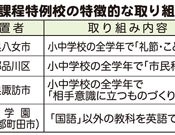
March 4, 2013 Kenta Masuda of Ryukyu Shimpo
The Nakagusuku Education Board will permit elementary schools teach the history of the Ryukyu Islands from the 2014 academic year by taking advantage of a system that allows designated schools to create their own programs without strictly adhering to Education Ministry guidelines. The board aims to foster young people who are internationally active, and knowledgeable about local history. To start with they will allocate 15 hours a year, but they aim to eventually allocate 35 hours for such local content, which equates to one hour per week. The board has initiated an education reform project by utilizing subsidies that have been granted to municipalities by the central government since fiscal 2012. Teachers will begin to write the textbooks this April. Few education boards in Japan have taken advantage of this system for schools to teach their own local history, and this will be the first time that the history of the Ryukyu Islands will be taught.
Junior high schools are scheduled to begin the program in April 2015. The board will apply this summer to the Ministry of Education, Culture, Sports, Science and Technology to request approval of the program. Although elementary school students have been studying the history of the Ryukyu Islands in social studies classes using supplementary reading materials, the quality and quantity has heavily relied on the individual teacher, and only limited hours have been available to deliver the content. The board has confirmed the need to secure class hours for the program from kindergartens to junior high schools, and that the pupils need to be taught in a systematic manner.
Nakagusuku has Nakagusuku Castle, which is designated as a UNESCO World Heritage site, and the Ryukyuan lord Gosamaru based himself in the district during the Ryukyu Dynasty period. However, there have been limited opportunities to learn about the history of Nakagusuku, and such knowledge is crucial for cultural inheritance. The village plans to create a historical museum focusing on Gosamaru, and has been raising awareness among locals by the naming of the Gosamaru Athletics Stadium, and by creating the mascot character Gosamaru-kun.
Village mayor keisuke Hamada said, “We learned about notable figures from Japanese history such as Nobunaga and Ieyasu but we never studied the Sho Dynasty that ruled the Ryukyu Kingdom. By expanding the education environment, I want to provide the opportunity for students to learn the history of the Ryukyu Islands, and know about their ancestors.”
Many schools use the system to allow them to teach English to early and middle elementary school pupils. As of April 2012, there had been 148 cases (affecting 1527 schools) in cities such as Ginowan and Kanazawa in which some of the hours allocated for teaching life environmental studies and comprehensive studies were replaced with those for English studies.
Terminology: A system that allows designated schools to create their own programs without having to follow Education Ministry guidelines.
Schools can make their own timetable by utilizing this system. The system is part of the project for structural reform that the Koizumi administration launched, and local governments can permit schools in designated districts to create their own programs without following the Education Ministry guidelines. It began in 2003, and was simplified to its current form in 2008. Schools must abide by the teaching hours determined in the Education Ministry guidelines, the Minister permits designated schools to adjust the teaching hours if the schools satisfy certain requirements based on an application submitted by municipal education boards. As of April 2012, 206 cases had been designated, affecting a total of 2591 schools.
(English translation by T&CT, Mark Ealey)
Go to Japanese

March 2, 2013 Ryukyu Shimpo
On March 2, an opening ceremony was held in the domestic terminal building of the New Ishigaki Airport, at Shiraho in Ishigaki City. About 1000 people involved in the project attended, including representatives of the central government, the Okinawa Prefectural Government and local officials.
In his greeting, Okinawa Governor Hirokazu Nakaima said, “Allow me to offer you my hearty congratulations on the opening of the new airport.” He added, “I believe that this new airport will contribute to promoting the development of Okinawa as a hub of the South for international exchange.”
Minister in charge of Okinawa Ichita Yamamoto said, “We are delighted that the people’s earnest desire to open the new airport has been realized.” He went on to say, “Yaeyama has great potential for the future. We hope that as you embrace this opportunity you will be at the forefront of contributing to the development of Okinawa and Japan.”
(English translation by T&CT, Mark Ealey)
Go to Japanese
Pros of buying Viagra online:
Wondering why you should buy Viagra online at all? Okay with your current routine that requires regular visits to your doctor in order to get and renew your prescription? Well, looks like you don’t really know what you’re missing. Read on – there’s more to ordering Viagra over the Internet than meets the eye.













 Webcam(Kokusai Street)
Webcam(Kokusai Street)


